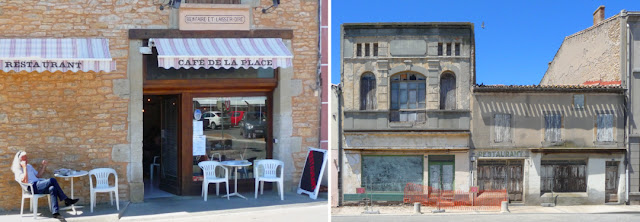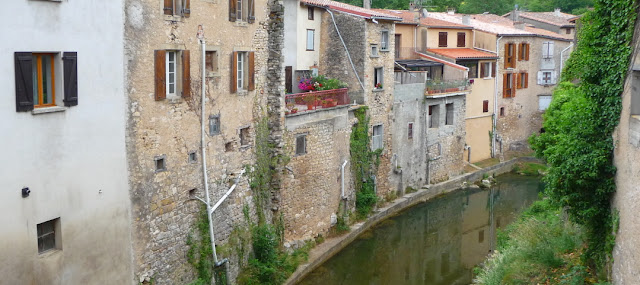In
the brochure of the exhibition, EVES ET REVES 'La Prehistoire Au
Feminine', at this modest little 'musee archeologique', I see
that the figurine is described as 'statuette obèse.' And she
has traces of 'de colouration rouge.' The flush of wine... the
burn of the sun?
Even
though I carry within me a tiny trace of genetic material from
Esclarmonde, my Cathar ancestor from the 12th century, I
haven't inherited any of her traits. No leanings towards austerity or
saintliness or hard work or martyrdom. Instead, a hedonistic
disposition and a particular love of food and wine.
I
have definitely been overdoing it with the cheeses, desserts, rich
sauces and wines. I went to buy a new shirt today and found that I
have increased by two sizes in just nine weeks. I am now eXtra
eXtra Large. Apparently one morning's walking each week
isn't enough to burn up the calories from the divine wine and French
cuisine.
We
joined a walking group this week for a fairly gruelling hike in the
hills around Limoux, but, appetites stimulated, we followed this with
one of those French three course lunches which involves a salade entrée, a lapin [rabbit] casserole in a rich sauce, and a
chocolate pudding with crème anglaise or a crème catalan.
And all of it washed down with a pitcher of rose and a coffee...
Total price? Thirteen euro. Too easy. And too fattening.
 |
| Same 'Place'... different eras. |
And
the blanquette! The cheap, fizzy, but very
good, wine which the Benedictine Monks at Abbaye
Saint- Hilaire invented in 1531, well before champagne was a
twinkle in anyone's glass. My theory is that because they were a
silent order, they needed something exceptional to drink to make life
merry, and they had time on their hands to experiment.
The
Limoux Blanquette is still the signature wine of the region and is
relentlessly promoted along with the Cathar
history; bubbles and bibles.
 |
Abbaye
Saint- Hilaire.
|
Unfortunately,
with all of this indulgence, my stomach is revolting [in more ways
than one!]. A couple of bad bouts of reflux during the night convince
me of the need to be more moderate.
We
must walk more I decide. So we take an evening stroll around the
village, ending up at our only bar/restaurant, for a glass of wine.
When Madame tells us that she has fresh salmon tonight, we have
to reserve a table for dinner. And of course it is warm and still and
beautiful in the courtyard which is enclosed by a sheer granite cliff
on one side and a tall stone house and leafy trees on the other.
There
are three courses, including the 'saumon' with a buttery
tarragon sauce. Madame, who cooks the salmon and picks the herbs for
the sauce from the courtyard garden and wears a short tight sexy
dress, asks if we like it. Dave replies, “C'est impeccable” and
she goes into raptures, her arms flapping like a sparrow's and her
expression simultaneously coy and ecstatic.
“It
comes from Norway,” she says. “It is not fatty like the others.”
“But
it is probably very tired,” Dave says.
Luckily
our host/chef had spent a summer living in England as a schoolgirl,
so she understands the joke. Well at least she appears to laugh.
There
is a reason for Dave's use of the word 'impeccable'... pronounced
'ahm-pek-arb(l)'
He
is losing confidence in his ability to communicate in French, so I
read him the appendix from Terry Darlington's book, 'Narrow Dog to
Carcassonne'. It explains how to speak French in fifteen minutes.
Terry
writes;
“Impeccable
– the nearest we have in English is the obsolete 'top hole'. Just
say “impeccable, impeccable” quietly every 5 seconds and smile,
with a few simple hand gestures. The land and all that is in it will
be yours.”
I
urge Dave to try it and it certainly seems to have the desired
effect.
Unlike
Dave, I am conversing fluently with the waitress. Or perhaps she is
speaking and I am smiling and nodding and saying “Oui, oui,” or
“d'accord” at what seem like suitable intervals.
“You
are doing well with your French” Dave says.
“Oh
no. I don't understand a thing. I just guess what she is saying,
watch her facial expressions and arm movements, and choose an
innocuous response.”
We
have decided that I am in fact a throw back to Stone Age woman.
Somehow I missed the intervening evolutionary stages. That must be
why I feel an affinity with this region. Some of the earliest human
remains of Stone Age dwellers in Europe, Homo Erectus ,from
half a million years ago, come from Languedoc. They were found near
Perpignan, an hour or so from here, in the early 1970s.
Archaeologists continue to unearth layer upon of pre-history here.
Every
subsequent wave of humans in the region achieved dominance through
their skills with technology [and sometimes with a good dose of
aggressiveness or ruthlessness].
First
the Neanderthals took over, around 150,000 BC. Their advances in tool
making meant they could hunt bigger beasts, the elephants and
mammoths of the area, rather than chucking stones at smaller birds
and animals. They made fires, and kindled the development of early
religion and culture.
From
around 35,000 BC, modern humans, Homo Sapiens, moved into
Languedoc and gained ascendancy by 14,000 BC. Dave and I saw their
awesome cave paintings of the animals they hunted at Niaux and they
made Venus statuettes, like some that we are viewing in Bram. In
time, fishing, agriculture and animal husbandry were developed as the
inventive Homo Sapiens further
advanced technology.
 |
|
'EVES ET REVES'
left: SHTOJ 14086 2,200 BC, Bronze ancien (Albanie)
middle: VENUS A LA CORNE 22,000 BC, Piquealeolith
gravetto-solutreen (France)
right: TURRIGA 2,500 BC, Néolithique récent (Italie)
|
 |
| Bram 'en Place' |
The
technology thing certainly passed me by! And I am quite a gentle
soul, easily intimidated by bullies. I am totally inept, even with
the simplest technology. I have trouble remembering which way to turn
the door handle in the house I have lived in for over twenty years.
Remote-controls send me into catatonic states.
My
emotions override thought. I rely on non-verbals in communication.
Senses and intuition are strong.
Yep.
Definitely a stone age woman, and increasingly resembling one of
those figurines, the early fertility goddesses from the paleolithic
age, around 23,000 B.C.































